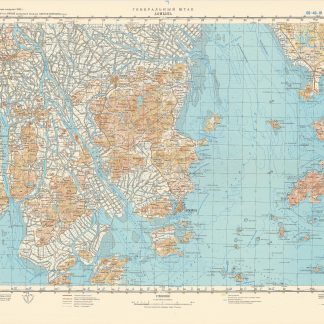General'nyí shtab. (Japan 1:200,000).
A total of 152 topographic maps, colour-printed, ca. 45 x 45 cm - 47 x 55 cm. Constant ratio linear horizontal scale. In Russian (Cyrillic).
€ 20.000,00
The Soviet Union's 1:200,000 General Staff map quadrangles showing Japan: from the Russian series of maps produced during the Cold War, based on high-quality satellite imagery, but usually also ground reconnaissance. All three main islands are very well covered, showing many large cities including Sappora, Tokyo, Hiroshima and Fukuoka, as well as Busan in North Korea and several small islands. Assembled continuously, the quadrangles would form an enormous map spanning roughly 17 x 16 metres!.
Products of a massive, clandestine cartographic project begun under Stalin and ultimately encompassing the entire globe, the Soviet General Staff maps are today noted for their extreme precision. Indeed, even in post-Soviet times they provide the most reliable mapping for many remoter parts of the world: "Soviet-era military maps were so good that when the United States first invaded Afghanistan in late 2001, American pilots relied on old Russian maps of Afghanistan. For almost a month after the United States began a bombing campaign to help oust the Taliban government, American pilots were guided by Russian maps dating back to the Soviet occupation of Afghanistan in the 1980s" (Davies/Kent, p. xi).
Although the details of the cartographic programme evolved over the decades, its overall system and plan remained remarkably constant. "The basic quadrangle is the 1:1,000,000 sheet spanning 4° latitude by 6° longitude [...] Each 1:1,000,000 sheet is [...] subdivided into 36 1:200,000 sheets in a six-by-six grid [... They] normally contain on the reverse side a detailed written description of the districts (towns, communications, topography, geology, hydrology, vegetation, and climate) together with a geological sketch map" (ibid., p. 19-21). "Printing such large-format plans in so many colors with near-perfect print registration itself testifies to the skill of the printers in the military map printing factories across the former Soviet Union. The quality of printing reflects the level of training and the reliability of humidity-control equipment and the electricity supply at the time" (ibid., p. 6f.).
Traces of folds, occasional odd edges, but altogether very well preserved.
Cf. J. Davies / A. J. Kent, The Red Atlas (Chicago/London, 2017).






